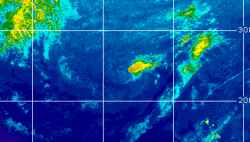Beach
Weather Guru

Reged:
Posts: 187
Loc: Cocoa Beach/Banana River
|
|
Have any of you taken a look at currents / winds to see where the oil is moving to?
"Up to 336,000 gallons could spill into the Gulf, based on the amount of oil the rig pulled out daily, O'Berry told CNN. And up to 700,000 gallons of diesel fuel could also leak, Coast Guard Petty Officer Ashley Butler said."
"A 1-by-5-mile sheen of crude oil mix has spread across the Gulf of Mexico's surface around the area where an oil rig exploded and sank, a Coast Guard lieutenant said Thursday."
The oil rig was 52 miles southeast of Venice, Louisiana,
It would a awful if the oil made it's way to the LA shoreline even worse if it made it to the FL Coast line.
(Post was moved to the appropriate Forum - it was off-topic for the Main Page thread.)
Edited by Ed Dunham (Sun Apr 25 2010 10:59 AM)
|
Beach
Weather Guru

Reged:
Posts: 187
Loc: Cocoa Beach/Banana River
|
|
A great concern of mine is that we are witnessing the set up for an ecological disaster. What was 40 sq miles of oil slick has now become 48 miles long and 80 miles wide.
According to Coast Guard Petty Officer Erik Swanson.
They have not been able to secure the tap at the bottom of the Gulf floor 5000 feet below the surface, and 1000 gallons of oil is leaking into the Gulf Daily.
The Coast Guard is scrambling to protect the shores of LA, AL, FL, TX.
With an active storm season on the way, and thousands of gallons of oil floating around, I can't help but wonder the impact on the shores of the entire gulf coast.
http://www.chron.com/disp/story.mpl/ap/business/6977422.html

|
Beach
Weather Guru

Reged:
Posts: 187
Loc: Cocoa Beach/Banana River
|
|
Oil slick as big as R.I., and growing
Officials: Nesting birds, whales and oyster beds at risk
Updated Link...
http://www.msnbc.msn.com/id/36800673/ns/us_news-environment/?gt1=43001
|
Beach
Weather Guru

Reged:
Posts: 187
Loc: Cocoa Beach/Banana River
|
|
"BP says oil leak may be bigger than it thought
Company official says Gulf well may be spewing out 5,000 barrels a day"
WOW you know when they start talking barrels and not gallons it's getting bad.
5000 barrels = 275,000 gallons A DAY !
Now there is speculation that if the "Burn Off" doesn't work it could take 60-90 days to cap the leak.
275,000 X 60 = 16,500,000 GALLONS OF OIL in the GULF.
On top of an active Hurricane Season... We could effectively see our Beach's ruined from Texas to Key West.
http://www.msnbc.msn.com/id/36800673/ns/us_news-environment

|
danielw
Moderator

Reged:
Posts: 3527
Loc: Hattiesburg,MS (31.3N 89.3W)
|
|
If my interpretation of 30 CFR is correct they have to over estimate the spill by four times the actual amount.
Hence the increase from 1500 to 5000 barrels per day of leakage.
Based on the subsea ROV photos the 1500 bbl seems a bit high.
Also note that there are many different estimates of the well leakage and the conversion between barrels and gallons varies from site to site.
1 API (American Petroleum Institute) barrel is 42 US gallons.
For example 1 gal of paint normally covers 350 square feet. (Industry average)
Edited by danielw (Sun May 02 2010 01:36 PM)
|
mstng
Unregistered
|
|
When things get rolling on here in a few weeks I promise to keep quiet like I have since . Until then, I would be interested to hear your theories regarding the effects a early June tropical storm would have on a oil slick. Thanks
(Post was moved to the appropriate Forum.)
Edited by Ed Dunham (Fri May 14 2010 11:02 AM)
|
MichaelA
Weather Analyst

Reged:
Posts: 956
Loc: Pinellas Park, FL
|
|
Quote:
I would be interested to hear your theories regarding the effects a early June tropical storm would have on a oil slick. Thanks
Trying not to think about that. It probably would be environmentally devastating.
--------------------
Michael
PWS
|
Beach
Weather Guru

Reged:
Posts: 187
Loc: Cocoa Beach/Banana River
|
|
Well looking at a few links the oil slick is getting very close to the Thermal loop in the Gulf. (sorry you got to copy the whole link)
1st Link: http://response.restoration.noaa.gov/top...topic)=entry_id,subtopic_id,topic_id&entry_id(entry_subtopic_topic)=809&subtopic_id(entry_subtopic_topic)=2&topic_id(entry_subtopic_topic)=1
2nd link : http://www.ssd.noaa.gov/goes/east/gmex/flash-ir4.html then click on the SST box the thermal loop shows up well, currently 27/28 degrees C 
|
Ed Dunham
Former Meteorologist & CFHC Forum Moderator (Ed Passed Away on May 14, 2017)
Reged:
Posts: 2565
Loc: Melbourne, FL
|
|
Try this link:
NOAA Oil Slick Projections
The forecasts are updated daily around 9pm EDT.
ED
|
weather fan
Unregistered
|
|
I'm a frequent browser of this site during hurricane season, as my folks live in the Tampa Bay area. I'm curious to find out from any of the experts here what impact tropical storms or hurricanes might have on the continuing oil spill disaster in the Gulf of Mexico.
Thanks so much for this excellent Web site.
Brian
(Posts moved to the appropriate Forum.)
Edited by Ed Dunham (Wed May 19 2010 05:50 PM)
|
hogrunr
Weather Guru

Reged:
Posts: 153
Loc: Spring, TX
|
|
Two different links on the subject:
Hurricanetrack.com
Scroll Down to the May 5th post.
Jeff Masters Blog
|
Beach
Weather Guru

Reged:
Posts: 187
Loc: Cocoa Beach/Banana River
|
|
Great Link Ed, THANKS !
This is and important read:
http://www.msnbc.msn.com/id/37248587/ns/us_news-the_new_york_times
Just as I thought from the start... the "powers that be" will down play this travesty.
Instead of News Sources pointing there cameras at stupidity, they need to be in the Gulf EVERY DAY... ASKING QUESTIONS EVERY DAY... DEMANDING ANSWERS EVERY DAY ! It my belief that we are witnessing the ecological destruction of the Gulf, to be felt and dealt with for a long time to come.
OK ... Who's turn is it next on the "Soap Box"
:?:
|
Storm Hunter
Veteran Storm Chaser

Reged:
Posts: 1370
Loc: Panama City Beach, Fl.
|
|
National Oceanic and Atmospheric Administration Deploys Additional High Powered Research Aircraft to Gulf to Help Monitor Air Quality
DATE: June 08, 2010 18:34:12 CST
WASHINGTON -- A second National Oceanic and Atmospheric Administration WP-3D Orion aircraft was deployed to the Gulf today to build on current air quality monitoring efforts near the BP Deepwater Horizon Oil Spill. The NOAA plane conducted two flights over and around the spill site to detect pollutants and their reaction products released into the atmosphere by the oil, as well as the pollutants and smoke from controlled burns. The flights will enable researchers to better understand the spill’s atmospheric effects.
As part of the federal government's ongoing response to the BP spill, the Environmental Protection Agency (EPA) continues its extensive air quality monitoring along the Gulf Coast. In this case, NOAA and EPA are working collaboratively to take advantage of NOAA’s highly specialized atmospheric research capabilities, which can detect concentrations of compounds in the atmosphere with greater sensitivity than standard operational monitoring flights. The P-3 is currently involved in a major climate and air quality study in California, called Calnex, which is why it is already properly outfitted for this emergency gulf mission. Another NOAA P-3 is also in the Gulf and has done multiple flights to help monitor the location of the loop current.
“We’re taking every step we can to ensure the health and safety of Gulf Coast residents and oil spill responders,†said EPA Administrator Lisa P. Jackson. “The data we gather through this next step in our partnership with NOAA will enhance efforts to monitor the air we breathe and better prepare us to address the long-term impacts of the BP oil spill.â€
"Ensuring the health and safety of Gulf Coast families is a priority for NOAA,†said Jane Lubchenco, under secretary of commerce for oceans and atmosphere and NOAA administrator. "We want to make certain that the air is safe for coastal residents as well as workers on the water. We are pleased to partner with EPA in this effort and to provide state-of-the-science air quality instruments in our flying laboratory aboard the P-3 aircraft."
Both NOAA Administrator Jane Lubchenco and EPA Administrator Lisa P. Jackson were in the Gulf region last week overseeing the ongoing federal response operations.
Operated by NOAA’s Office of Marine and Aviation Operations, the NOAA WP-3 Orion “hurricane hunter†plane is currently configured as a high-tech flying chemistry laboratory that can collect and provide near real-time air-quality data to scientists on the aircraft and on the ground. Scientists onboard will also collect air samples that will be sent to the laboratory to be analyzed for additional compounds.
Much of the sampling will be conducted below 1,000 feet, in what is called the marine boundary layer, where scientists expect most of the pollutants to be trapped. They will collect data from as close to the sea surface as allowed by safe aircraft operation, with plans to go as low as 200 feet, to monitor for pollutants near the surface and up to 1,000 feet or more to track how the pollutants move through the air. The many measurements gathered from the flights will enable scientists to distinguish emissions associated with the leaking oil well from other sources, such as ships and aircraft operating in the area.
Both NOAA and EPA will combine their measurements with model simulations to provide a broader overall picture of air quality impacts from the BP Deepwater Horizon oil spill.
NOAA’s mission is to understand and predict changes in the Earth's environment, from the depths of the ocean to the surface of the sun, and to conserve and manage our coastal and marine resources.
ON THE WEB:
www.NOAA.gov
www.epa.gov/bpspill
For information about the response effort, visit www.deepwaterhorizonresponse.com.
Edited by Storm Hunter (Tue Jun 08 2010 07:46 PM)
|



 Threaded
Threaded









